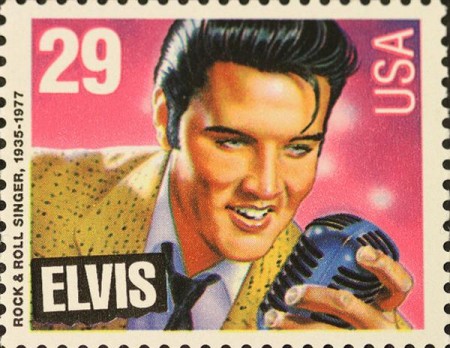“Man, when I was nine, I couldn’t imagine anyone not wanting to be Elvis Presley,” Springsteen remembers.
The first two Elvis Presley albums, both on RCA in 1956, neatly illustrate the basic dichotomy: Elvis Presley shows him onstage, eyes shut and mouth wide open, with his guitar thrust in the air, while Elvis has him seated in a staged pose, strumming his guitar. Here is the musician, they seem to say, and here are his musical instruments, his primary materials: his voice and his guitar.
In the 1960 songs in which women are part of the continuing love relationship, the male is clearly the dominant figure. Elvis Presley in “It’s Now or Never” best exemplifies this theme:
It’s now or never.
Come hold me tight.
Kiss me, my darling.
Be mine tonight.
Tomorrow will be too late.
It’s now or never.
My love won’t wait.
Alan Freed and others only played original black rhythm & blues /r ock’n’ roll, but most disk jockeys gave the cover version for more exposure, usually omitting to mention the original. Covers by leading white perforrners such as Pat Boone consistently outsold the originals over the country as a whole. To same people only the original black music had the necessary connotations of non-conforrnity, but for many middle-class teenagers clean-living Pat Boone’s perfectly enunciated version of Little Richard’s Long Tall Sally offered enough assertiveness without too much risk of overstepping the social and moral mark.
The lyrics of Sh-Boom were unaltered in the Crew Cuts’ cover version, but that was an exception; in many cases wholesale changes were made to cope with lyrics of unaccustomed frankness and innuendo. The music of the covers was also often toned down. These changes, undertaken partly to avoid incurring society’s wrath, partly to ensure good sales, could not disguise the fact that penetration of the mainstream by black and black-derived approaches was taking another, decisive step. The interplay between the offbeat and heavy, insistent rhythm were different from anything the white popular music scene had heard before. In introdueing new elements, mostly derived from the blues, cover versions unwittingly helped to prepare a wider audience for the music that foilowed.
The cover version remained the basis of the white rock’n’ roll of Bill Haley, Elvis Presley and others, but a different approach can be detected between these and the version of the Pat Boone school. In place of the attempt to divert rhythm & blues into more broadly acceptable channels of sound, the country-bred musicians and their producers sought to develop a new style, based on a dynamic encounter between black and white.
Notice that Blood Sweat and Tears and the Ides of March have names that come at the end of a quotation, so that to get it you have to know the first part as well. Since almost all American kids have to read Julius Caesar in high school, that Shakespearean tag is especially indicative. Furthermore, these names as well as that of Big Brother promise something threatening. Music was so loud and so heavy that it did have an aggressive quality—so that it is no surprise that in 1969 a group formed that called itself War.
Related Links
Continue Reading
View More Popular Culture Articles
Views: 2622








